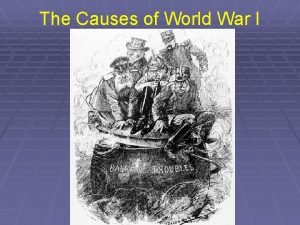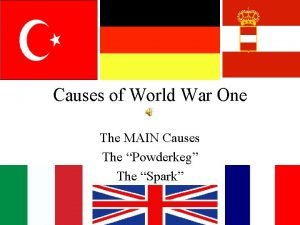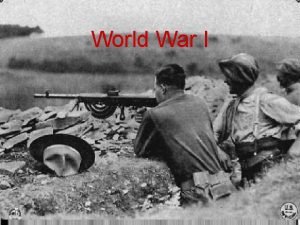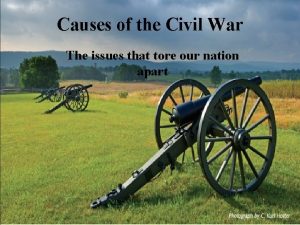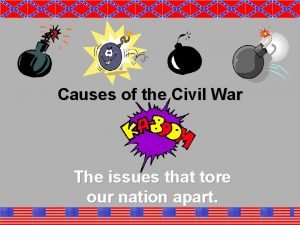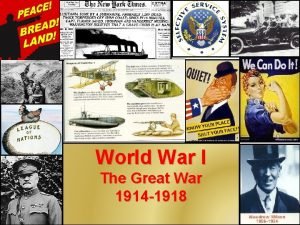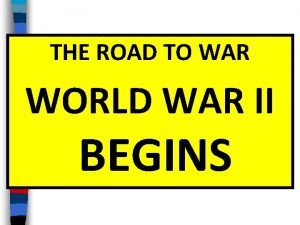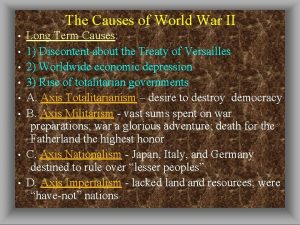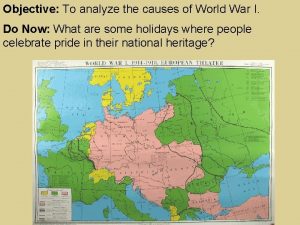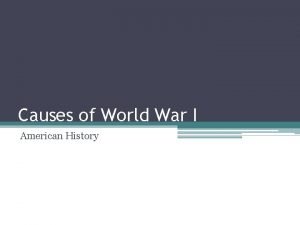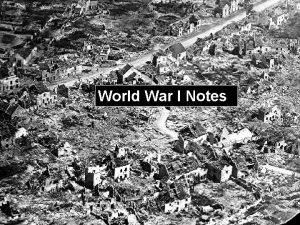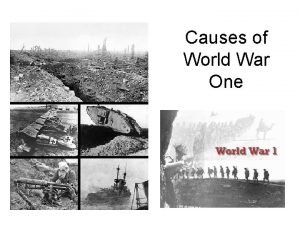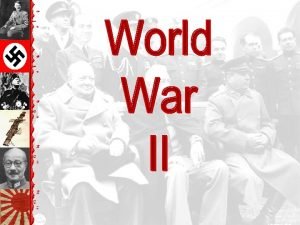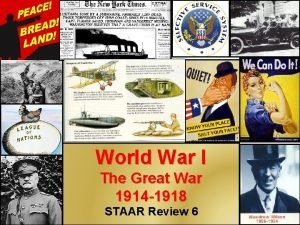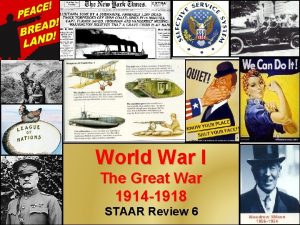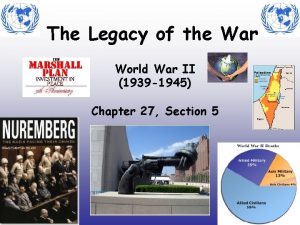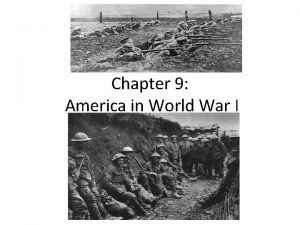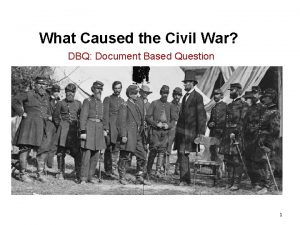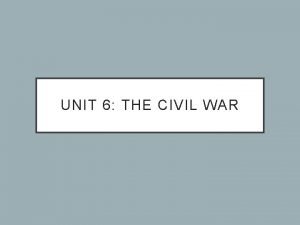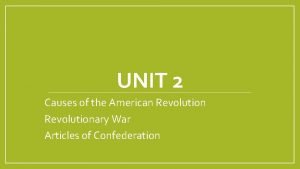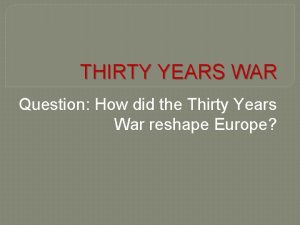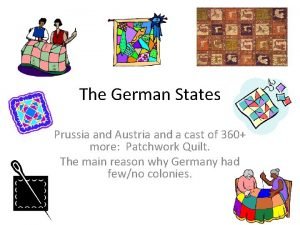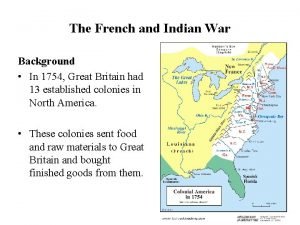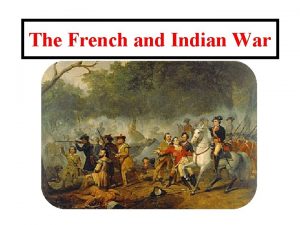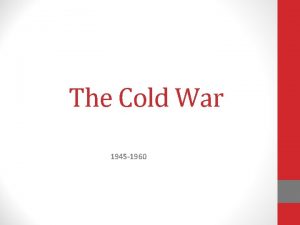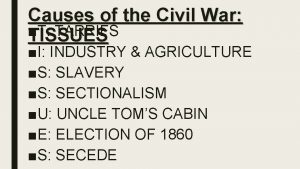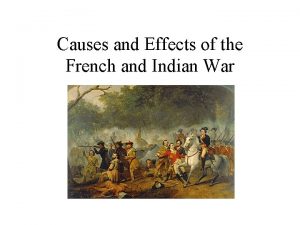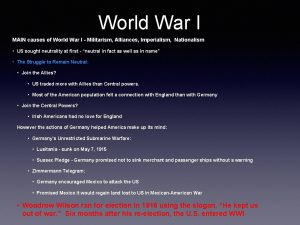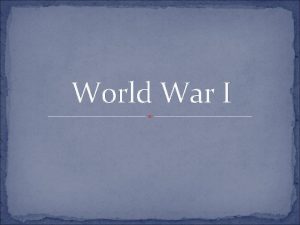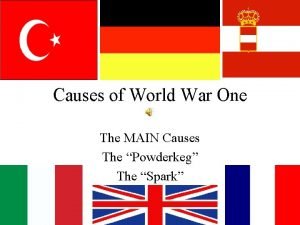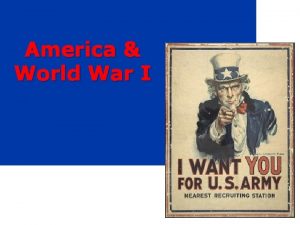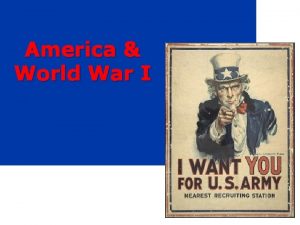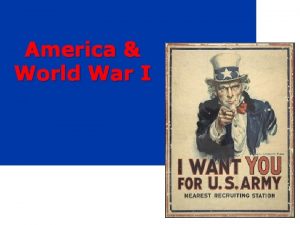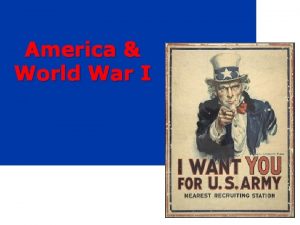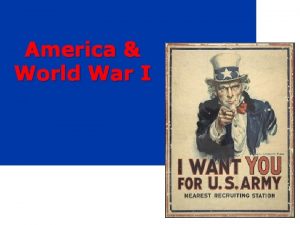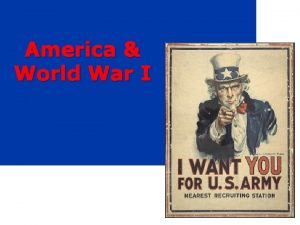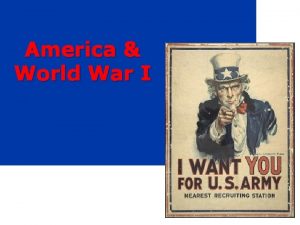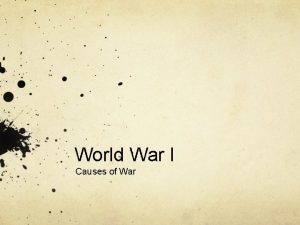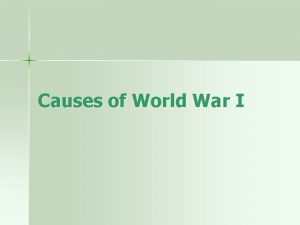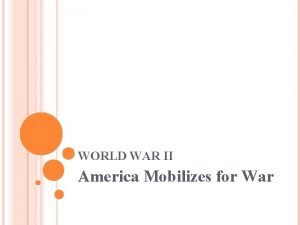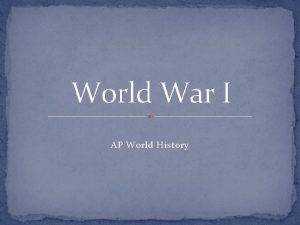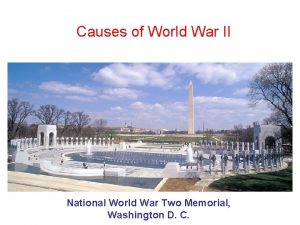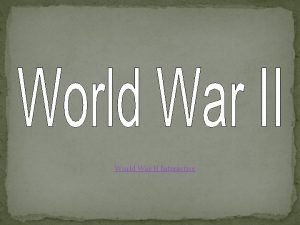America World War I w MAIN Causes of








































- Slides: 40

America & World War I

w MAIN Causes of WWI 1. Militarism – the aggressive buildup of a nations armed forces. 2. Alliances – nations formed partnerships to help protect and defend themselves. 3. Imperialism – stronger nations began to take over weaker nations. 4. Nationalism – everybody thought their nation was the best.

MILITARISM


The First World War: What? • War involving nearly all the nations of the world When? • 1914 -1918 5

The First World War: Why? Long term 1. Alliance system 2. Imperialist Competition 3. Stockpiling of Weapons Austria - Franz Ferdinand & daughter of Leopold Salvator. Upper right: Cardinal Nagle 6 Short term Assassination of Franz Ferdinand of the Austro-Hungarian Empire

Which side should the US pick? Central Powers: Allies: • 11 million German. Americans • Irish-Americans hated Great Britain • Close cultural ties • Shared transatlantic cables (so censored stories) • Big business loaned much $ to allies US Exports to both sides: 7

SYSTEM OF ALLIANCES

The First World War: Who? Central Powers: Germany Austria-Hungary Ottoman Empire Bulgaria 9 Allies: Russia France Great Britain Italy Japan United States (1917)

Why did it take so long for America to get involved in the war? • America was isolationist • “Why should I get involved in someone else’s problems” 10

Another movement in the U. S. • Interventionists – the war affected U. S. interests so we should help the Allies.

What did it take to get the US involved? 1. German invasion of Belgium Y T I C O R T A 12 S E I R STO

What did it take to get the US involved? 2. Blockades • Britain blockaded (stopped) all German ships going to America • Germany announced a submarine war around Britain 13

What did it take to get the US involved? 3. Unlimited Submarine Warfare • 1917 Germany announced “unlimited submarine warfare” in the war zone Why? Otherwise their blockade would not be successful 14

What did it take to get the US involved? 4. Lusitania • In May, 1915 Germany told Americans to stay off of British ships • They could/would sink them 15


What did it take to get the US involved? 4. Lusitania • Lusitania torpedoed, sinking with 1200 passengers and crew (including 128 Americans) • Was eventually found to be carrying 4200 cases of ammunition 17

18


What did it take to get the US involved? 4. Lusitania • The US sharply criticized Germany for their action • Germany agreed not to sink passenger ships without warning in the future 20

What did it take to get the US involved? 5. Zimmerman Note • US intercepted a note from Germany to Mexico • It promised Texas, New Mexico, and Arizona back in return for an alliance 21

What did it take to get the US involved? • Zimmerman Note and the sinking of 4 unarmed American ships led to a declaration of war 22

How was the war looking for the allies? Not Good. . . • Russia left the war after its communist revolution in 1917 • Made it a one front war for Germany - all its troops could concentrate on France 23

24

What did the US do to help? Supplies: • US provided the food, money, and fresh troops needed to win the war 25

Convincing the American People Posters - Gee!! • How do you think this poster helped to convince the American people that the war was a good idea? 26

Convincing the American People Idealism: 2 Goals For War: 1. War to End All Wars 2. Making the World Safe for Democracy 27

MOBILIZING FOR WAR Sale of Liberty Bonds War Industries Board To convert from peacetime to wartime production Selective Service Act Authorizes the draft for military service • Conscientious objectors

Trench Warfare Trench warfare is a form of land warfare using occupied fighting lines consisting largely of trenches, in which troops are significantly protected from the enemy's small arms fire and are substantially sheltered from artillery. The most prominent case of trench warfare is the Western Front in World War I. 29

New Technology Weapons 1. Machine guns 2. Anti-artillary guns (cannons) 3. Tanks 30

Deadly Technology of WWI Machine guns Artillery field guns Submarines Tanks & armored cars Airplanes Poison gas Improved machine guns could fire 600 bullets per minute. These long-range cannons caused more casualties than any other type of weapon. German U-boats used torpedoes as well as on-deck guns to sink ships. Both sides tried to develop vehicles that could go over the rough ground & barbed-wire barricades. Planes were used for reconnaissance, bombing, & fighting but did not prove decisive. Gases such as chlorine, phosgene, & mustard gas could kill, blind, or burn their victims.

Convincing the American People Idealism: Fourteen Points What? President Wilson’s Plan for after the war • Fourteen promises, including freedom of the seas & a League of Nations to work for peace 32 President Woodrow Wilson

14 POINTS January 1917 CAUSE OF WAR WILSON’S REMEDY Militarism Peace w/o victory Secret alliances No secret treaties Nationalism Self-determination Imperialism Freedom of the seas International anarchy League of Nations DECISION AT PARIS PEACE CONFERENCE • Germany pays reparations • Iraq is attached to Britain as a mandate • In Europe & Middle East, ethnic groups are clustered together randomly

How did the War Affect the US? Women • Women filled factory jobs • May have led 19 th Amendment after the war (Gave women the right to vote) African Americans • Black soldiers still served in Segregated Units 34 • “Great Migration” - thousands of African Americans moved North to work in factories

The Great Migration During World War I and after, several push factors caused thousands of African Americans to decide to move away from their homes in the South. A handful of pull factors drew them to new homes in the North. Pushed from the South by… Pulled to the North by… Jim Crow segregation laws Economic prosperity in northern cities Lynchings and other racial violence Job openings due to reduced immigration Low-paying jobs as sharecroppers Aid from African Americans in the North Ruined cotton crops due to boll weevils


How did the War Affect the US? Enforcing Loyalty • Hatred of all things German • Ex. “Liberty Cabbage” • Espionage Act 1917 & Sedition Act of 1918 punished those against the war (many labor leaders) 37

Eugene Debs delivering the 1918 Canton, Ohio speech that led to his incarceration

SCHENCK vs U. S. (1919) Issue Schenck sent anti-draft circulars through the mails He was charged with violating the Espionage Act Schenck argued his rights under the 1 st Amendment Supreme Court Decision ‘ clear and present danger’ Significance Curtailment of civil liberties in times of war

40
 Main causes of world war 1
Main causes of world war 1 Causes of wwi main
Causes of wwi main What caused ww1
What caused ww1 What were the 4 main causes of the civil war
What were the 4 main causes of the civil war What are the 3 main causes of the civil war
What are the 3 main causes of the civil war Rap of the states
Rap of the states 3 cause of ww1
3 cause of ww1 Ww2 causes
Ww2 causes Ww2 long term causes
Ww2 long term causes Causes of world war 1 mania
Causes of world war 1 mania Causes of world war 1 mania
Causes of world war 1 mania What were the mania causes of wwi?
What were the mania causes of wwi? What are the underlying causes of ww1
What are the underlying causes of ww1 Cause of world war 2
Cause of world war 2 Causes of world war 2
Causes of world war 2 4 causes for ww1
4 causes for ww1 Main causes of ww1
Main causes of ww1 Causes of world war 2
Causes of world war 2 Chapter 9 america in world war 1
Chapter 9 america in world war 1 Ultimate vs proximate causation
Ultimate vs proximate causation Proximate and ultimate behavior examples
Proximate and ultimate behavior examples America asia africa
America asia africa Whats an onomatopeia
Whats an onomatopeia Why is called latin america
Why is called latin america Performance e body art
Performance e body art What caused the civil war dbq
What caused the civil war dbq What were some causes of the civil war
What were some causes of the civil war Main causes of the american revolution
Main causes of the american revolution Thirty years' war causes
Thirty years' war causes What caused cold war
What caused cold war The causes of the korean war
The causes of the korean war 30 years war causes
30 years war causes What caused the french and indian war
What caused the french and indian war Causes of french and indian war
Causes of french and indian war Causes and effects of the cold war
Causes and effects of the cold war Myjeopardy
Myjeopardy Causes of vietnam war
Causes of vietnam war Tissues causes of civil war
Tissues causes of civil war Cause of korean war
Cause of korean war What caused the seven years war
What caused the seven years war Causes and effects of the french and indian war
Causes and effects of the french and indian war
